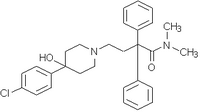METHOD OF PREPARATION
Note: The lecithin-isopropylpa-Imitate solution can be prepared by mixing 0.2 g sorbic acid, 50 g of soy lecithin and 50 g of isopropyl palmitate. The Pluronic F127 solution can be prepared by mixing 0.2 g sorbic acid, 30 g of Pluronic F127 and sufficient purified water to make 100 m.L.
1. Calculate the required quantity of each ingredient for the total amount to be prepared.
2. Accurately weigh and/or measure each ingredient.
3. Prepare a paste of the ketoprofen and loperamide and the propylene glycol.
4. Incorporate the lecithimisopropyl palmitate solution into the paste and mix until uniform.
5. Add sufficient Pluronic F127 30% gel to volume and mix using a high-shear mixing method.
6. Package and label.
PACKAGING
Package in tight, light-resistant containers.1
LABELING
Keep out of reach of children. Use only as directed. For external use only.
STABILITY
A beyond-use date of up to 6 months would be appropriate for this preparation.1
USE
Ketoprofen and loperamide in Pluronic lecithin organogel has been used in the treatment of shingles and postherpetic neuralgia.
QUALITY CONTROL
Quality-control assessment can include theoretical weight compared to actual weight, pH, specific gravity, active drug assay, color, clarity, texture-surface, texture-spatula spread, appearance, feel, rheological properties and physical observations.2
DISCUSSION
Numerous combinations of active ingredients and many different types of penetration-enhancing gels are commonly used. The combination of ketoprofen and loperamide has been used in the treatment of shingles and postherpetic neuralgia pain.
Ketoprofen (C^sub 16^H^sub 14^O^sub 3^, M.W 254.28) occurs as a white or almost white, odorless or almost odorless, crystalline powder. It is practically insoluble in water but freely soluble in alcohol and ether. Ketoprofen has analgesic, anti-inflammatory and antipyretic properties and is an inhibitor of cyclo-oxygenase. It should be preserved in tight containers.1,3
Loperamide (C^sub 29^H^sub 33^ClN^sub 2^O^sub 2^-HCl, MW 513.50) is a synthetic piperidine derivative used as an antiperistaltic antidiarrhea agent. It occurs as a white to slightly yellow powder. It is freely soluble in isopropyl alcohol and slightly soluble in water and dilute acids. It is commercially available as an oral solution, in oral tablets and in combination with simethicone as both swallowable and chewable tablets. The oral solution has a pH between 2.7 and 5.0.1
Propylene glycol (C^sub 3^H^sub 8^O^sub 2^, MW 76.09) occurs as a clear, colorless, viscous, practically odorless liquid with a sweet taste, somewhat resembling glycerin. It is miscible with acetone, chloroform, 95% ethanol, glycerin and water.4
Lecithin (egg lecithin, soybean lecithin, vegetable lecithin) describes a complex mixture of acetone-insoluble phosphatides. The composition and physical properties vary depending upon the source of the lecithin and the degree of purification. Physically, lecithin can range from a viscous semi-liquid to a powder. It is practically insoluble in water but, when mixed with water, hydrates to form emulsions.5
Isopropyl palmitate (C^sub 19^H^sub 38^O^sub 2^, MW 298.51) is a colorless, mobile liquid with a very slight odor that is used as an emollient, oleaginous vehicle and a solvent; it has good spreading characteristics. It is soluble in acetone, castor oil, cottonseed oil, alcohol and mineral oil. It is insoluble in water, glycerin and propylene glycol.6
Poloxamers (Pluronics) generally are white-colored, waxy, free-flowing granules or cast solids that are practically odorless and tasteless. Poloxamer 407 (Pluronic F-127) is generally available in powdered form. It is either odorless or may have a very mild odor.7
REFERENCES
1. US Pharmacopeial Convention, Inc. United States Pharmacopeia 27-NationaL Formulary 22. Rockville, MD: US Pharmacopeial Convention, Inc.; 2004: 978, 1102-1104, 2345-2349, 2768.
2. Allen LV Jr. Standard operating procedure for performing physical quality assessment of ointments/creams/gels. IJPC 1998; 2: 308-309.
3. Reynolds JE, ed. MARTINDALE: The Extra Pharmacopoeia. 30th ed. London: The Pharmaceutical Press; 1993: 21-22.
4. Weller PJ. Propylene glycol. In: Rowe RC, Sheskey PJ, Weller PJ, eds. Handbook of Pharmaceutical Excipients. 4th ed. Washington, DC: American Pharmaceutical Association; 2003: 521-523.
5. Fowler K. Lecithin. In: Rowe RC, Sheskey PJ, Weller PJ, eds. Handbook of Pharmaceutical Excipients. 4th ed. Washington, DC: American Pharmaceutical Association; 2003: 340-342.
6. Taylor AK. Isopropyl palmitate. In: Rowe RC, Sheskey PJ, Weller PJ, eds. Handbook of Pharmaceutical Excipients. 4th ed. Washington, DC: American Pharmaceutical Association; 2003: 314-315.
7. Collett JH. Poloxamer. In: Rowe RC, Sheskey PJ, Weller PJ, eds. Handbook of Pharmaceutical Excipients. 4th ed. Washington, DC: American Pharmaceutical Association; 2003: 447-450.
Copyright International Journal of Pharmaceutical Compounding Sep/Oct 2004
Provided by ProQuest Information and Learning Company. All rights Reserved



